Households’ Electricity Consumption in Hungarian Urban Areas
Abstract
:1. Introduction
2. Literature Review
- Increases the environmental impact [38].
3. Data and Methods
3.1. Application of Artificial Neural Networks
- -
- Classification tasks;
- -
- Optimalisation;
- -
- Approximation;
- -
- Analysis of nonlinear dynamic systems [64].
The Operational Principles of Network Theory and Artificial Neural Networks
3.2. Data
- Electrical power use (kWh);
- Registered employment seekers (%);
- Ratio of those 60 years-old and older within the permanent population (%);
- Number of people per household (person/household);
- City size (km2).
4. Results
4.1. The Modelling of Energy Consumption Using Various Statistical Tools
4.1.1. The Regression Procedure and Its Outcomes
- The number of people per household—its explanatory power within the model is 49%;
- The number of registered employment seekers, the predictive power of which is 28%;
- The ratio of those 60 years and older within the city’s permanent population—its predictive value is 22%.
4.1.2. The Results of the Estimation Carried Out by the Artificial Neural Network
- was the measured value in the given city;
- μ the given variable’s average value;
- σ the given variable’s standard deviation, that is to say, its average detour from the mean.
4.2. The Interpretation of Results for CO2
5. Discussion and Conclusions
Author Contributions
Funding
Institutional Review Board Statement
Informed Consent Statement
Data Availability Statement
Acknowledgments
Conflicts of Interest
Appendix A

References
- Shahbaz, M.; Shamim, S.A.; Aamir, N. Macroeconomic environment and financial sector’s performance: Econometric evidence from three traditional approaches. IUP J. Financ. Econ. 2010, 1, 103–123. [Google Scholar]
- HCSO. A Háztartások Életszínvonala. 2015. Available online: https://www.ksh.hu/docs/hun/xftp/idoszaki/hazteletszinv/hazteletszinv15.pdf (accessed on 7 February 2020).
- Fremstad, A.; Underwood, A.; Zahran, S. The Environmental Impact of Sharing: Household and Urban Economies in CO2 Emissions; No 2016-01, Working Paper Series; Dickinson College, Department of Economics: Carlisle, PA, USA, 2016; Available online: https://econpapers.repec.org/paper/dicwpaper/2016-01.htm (accessed on 7 February 2020).
- Khan, I.; Hou, F.; Zakari, A.; Tawiah, V.K. The dynamic links among energy transitions, energy consumption, and sustainable economic growth: A novel framework for IEA countries. Energy 2021, 222, 119935. [Google Scholar] [CrossRef]
- Wang, Q.; Zhang, F. What does the China’s economic recovery after COVID-19 pandemic mean for the economic growth and energy consumption of other countries? J. Clean. Prod. 2021, 295, 126265. [Google Scholar] [CrossRef]
- Yasmeen, H.; Tan, Q.; Zameer, H.; Vo, X.V.; Shahbaz, M. Discovering the relationship between natural resources, energy consumption, gross capital formation with economic growth: Can lower financial openness change the curse into blessing. Resour. Policy 2021, 71, 102013. [Google Scholar] [CrossRef]
- Dogan, E.; Altinoz, B.; Madaleno, M.; Taskin, D. The impact of renewable energy consumption to economic growth: A replication and extension of Inglesi-Lotz (2016). Energy Econ. 2020, 90, 104866. [Google Scholar] [CrossRef]
- Rahmani, O.; Rezania, S.; Beiranvand Pour, A.; Aminpour, S.M.; Soltani, M.; Ghaderpour, Y.; Oryani, B. An overview of household energy consumption and carbon dioxide emissions in Iran. Processes 2020, 8, 994. [Google Scholar] [CrossRef]
- Xu, B.; Zhong, R.; Liu, Y. Comparison of CO2 emissions reduction efficiency of household fuel consumption in China. Sustainability 2019, 11, 979. [Google Scholar] [CrossRef] [Green Version]
- Wu, W.; Zhu, H.; Qu, Y.; Xu, K. Regional disparities in emissions of rural household energy consumption: A case study of Northwest China. Sustainability 2017, 9, 726. [Google Scholar] [CrossRef] [Green Version]
- Wasti, S.K.A.; Zaidi, S.W. An empirical investigation between CO2 emission, energy consumption, trade liberalization and economic growth: A case of Kuwait. J. Build. Eng. 2020, 28, 101104. [Google Scholar] [CrossRef]
- Radmehr, R.; Henneberry, S.R.; Shayanmehr, S. Renewable energy consumption, CO2 emissions, and economic growth nexus: A simultaneity spatial modeling analysis of EU countries. Struct. Chang. Econ. Dyn. 2021, 57, 13–27. [Google Scholar] [CrossRef]
- Munir, Q.; Lean, H.H.; Smyth, R. CO2 emissions, energy consumption and economic growth in the ASEAN-5 countries: A cross-sectional dependence approach. Energy Econ. 2020, 85, 104571. [Google Scholar] [CrossRef]
- Bashir, M. Energy consumption, CO2 emissions and economic growth in developed, emerging and Middle East and North Africa countries. Energy 2019, 179, 232–245. [Google Scholar] [CrossRef]
- Salari, M.; Javid, R.J.; Noghanibehambari, H. The nexus between CO2 emissions, energy consumption, and economic growth in the U.S. Econ. Anal. Policy 2021, 69, 182–194. [Google Scholar] [CrossRef]
- Valadkhani, A.; Smyth, R.; Nguyen, J. Effects of primary energy consumption on CO2 emissions under optimal thresholds: Evidence from sixty countries over the last half century. Energy Econ. 2019, 80, 680–690. [Google Scholar] [CrossRef]
- Zhu, Y.-G.; Jones, K.C. Urbanisation and health in China. Lancet 2010, 376, 232–233. [Google Scholar] [CrossRef]
- Samper, J.; Shelby, J.A.; Behary, D. The paradox of informal settlements revealed in an ATLAS of informality: Findings from mapping growth in the most common yet unmapped forms of urbanization. Sustainability 2020, 12, 9510. [Google Scholar] [CrossRef]
- Cebrián Abellán, F.; Sánchez Ondoño, I. Urban sprawl in inner medium-sized cities: The behaviour in some Spanish cases since the beginning of the 21st century. Urban Sci. 2019, 3, 10. [Google Scholar] [CrossRef] [Green Version]
- Hynes, M. At a crossroads: Investigating automobility and its implications for local urban transport policy design. Urban Sci. 2017, 1, 14. [Google Scholar] [CrossRef] [Green Version]
- Bai, Y.; Deng, X.; Gibson, J.; Zhao, Z.; Xu, H. How does urbanization affect residential CO2 emissions? An analysis on urban agglomerations of China. J. Clean. Prod. 2019, 209, 876–885. [Google Scholar] [CrossRef]
- Sungwon, L.E.E.; Bumsoo, L.E.E. Comparing the impacts of local land use and urban spatial structure on household VMT and GHG emissions. J. Transp. Geogr. 2020, 84, 102694. [Google Scholar] [CrossRef]
- Elliot, T.; Babí Almenar, J.; Niza, S.; Proença, V.; Rugani, B. Pathways to modelling ecosystem services within an urban metabolism framework. Sustainability 2019, 11, 2766. [Google Scholar] [CrossRef] [Green Version]
- Zhang, J.; Yu, B.; Cai, J.; Wei, Y.M. Impacts of household income change on CO2 emissions: An empirical analysis of China. J. Clean. Prod. 2017, 157, 190–200. [Google Scholar] [CrossRef]
- Han, S.S.; Lim, Y. Battambang City, Cambodia: From a small colonial settlement to an emerging regional centre. Cities 2019, 87, 205–220. [Google Scholar] [CrossRef]
- Li, Y.; Jonas, A.E.G. City-regionalism as countervailing geopolitical processes: The evolution and dynamics of Yangtze River Delta region, China. Political Geogr. 2019, 73, 70–81. [Google Scholar] [CrossRef]
- Kovacs, Z.; Farkas, Z.J.; Egedy, T.; Kondor, A.C.; Szabo, B.; Lennert, J.; Baka, D.; Kohan, B. Urban sprawl and land conversion in post-socialist cities: The case of metropolitan Budapest. Cities 2019, 92, 71–81. [Google Scholar] [CrossRef]
- Nijkamp, P.; Reggiani, A. Nonlinear Evolution of Spatial Economic Systems; Springer: Berlin/Heidelberg, Germany, 1993. [Google Scholar] [CrossRef]
- Kondor, A.C.; Kovács, Z. Kibocsátáscsökkentés és urbanizáció: Ellentmondások és párhuzamok. Magy. Tudomány 2017, 6, 686–691. [Google Scholar]
- Wilkosz-Mamcarczyk, M.; Olczak, B.; Prus, B. Urban features in rural landscape: A case study of the municipality of Skawina. Sustainability 2020, 12, 4638. [Google Scholar] [CrossRef]
- Banski, J.; Wesołowska, M. Transformations in housing construction in rural areas of Poland’s Lublin region—Influence on the spatial settlement structure and landscape aesthetics. Landsc. Urban Plan. 2010, 94, 116–126. [Google Scholar] [CrossRef]
- Stevens, J.; Henderson, R.; Webber, J.; Evans, B.; Chen, A.; Djordjević, S.; Sánchez-Muñoz, D.; Domínguez-García, J. Interlinking Bristol based models to build resilience to climate change. Sustainability 2020, 12, 3233. [Google Scholar] [CrossRef] [Green Version]
- Jones, C.; Kammen, D.M. Spatial distribution of U.S. household carbon footprints reveals suburbanization undermines greenhouse gas benefits of urban population density. Environ. Sci. Technol. 2014, 16, 895–902. [Google Scholar] [CrossRef]
- Brückner, M. Economic growth, size of the agricultural sector, and urbanization in Africa. J. Urban Econ. 2012, 1, 26–36. [Google Scholar] [CrossRef]
- Zhou, Y.; Kong, Y.; Wang, H.; Luo, F. The impact of population urbanization lag on eco-efficiency: A panel quantile approach. J. Clean. Prod. 2020, 244, 118664. [Google Scholar] [CrossRef]
- Bao, C.; Xu, M. Cause and effect of renewable energy consumption on urbanization and economic growth in China’s provinces and regions. J. Clean. Prod. 2019, 231, 483–493. [Google Scholar] [CrossRef]
- Wang, Z.-X.; Hao, P.; Yao, P.-Y. Non-linear relationship between economic growth and CO2 emissions in China: An empirical study based on panel smooth transition regression models. Int. J. Environ. Res. Public Health 2017, 12, 1568. [Google Scholar] [CrossRef] [PubMed]
- Zheng, W.; Walsh, P.P. Economic growth, urbanization and energy consumption–A provincial level analysis of China. Energy Econ. 2019, 80, 153–162. [Google Scholar] [CrossRef]
- He, J.; Wang, S.; Liu, Y.; Ma, H.; Liu, Q. Examining the relationship between urbanization and the eco-environment using a coupling analysis: Case study of Shanghai, China. Ecol. Indic. 2017, 77, 185–193. [Google Scholar] [CrossRef]
- Koning, R.; Tan, W.G.Z.; van Nes, A. Assessing spatial configurations and transport energy usage for planning sustainable communities. Sustainability 2020, 12, 8146. [Google Scholar] [CrossRef]
- UN HABITAT. World Cities Report 2016; UN Habitat: Nairobi, Kenya, 2017; pp. 1–264. ISBN 978-92-1-132708-3. [Google Scholar]
- Mindali, O.; Raveh, A.; Salomon, I. Urban density and energy consumption: A new look at old statistics. Transp. Res. Part A 2004, 38, 143–162. [Google Scholar] [CrossRef]
- Shim, G.E.; Rhee, S.M.; Ahn, K.H.; Chung, S.B. The relationship between the characteristics of transportation energy consumption and urban form. Ann. Region. Sci. 2006, 40, 351–367. [Google Scholar] [CrossRef]
- Fremstard, A.; Underwood, A.; Zahran, S. The environmental impact of sharing: Household and urban economies in CO2 emissions. Ecol. Econ. 2018, 145, 137–147. [Google Scholar] [CrossRef]
- Jankó, F.; Móricz, N.; Pappné Vancsó, J. Klímaváltozás: Diskurzusok a katasztrófától a kételkedésig (2. rész). Földrajzi Közlemények 2011, 1, 3–16. [Google Scholar] [CrossRef]
- Ivanovski, K.; Hailemariam, A.; Smyth, R. The effect of renewable and non-renewable energy consumption on economic growth: Non-parametric evidence. J. Clean. Prod. 2020, 286, 124956. [Google Scholar] [CrossRef]
- Dogan, E.; Turkekul, B. CO2 emissions, real output, energy consumption, trade, urbanization and financial development: Testing the EKC hypothesis for the USA. Environ. Sci. Pollut. Res. 2016, 2, 1203–1213. [Google Scholar] [CrossRef] [PubMed]
- Giddings, B.; Hopwood, B.; O’brien, G. Environment, economy and society: Fitting them together into sustainable development. Sustain. Dev. 2002, 4, 187–196. [Google Scholar] [CrossRef]
- Perrings, C. Economy and Environment: A Theoretical Essay on the Interdependence of Economic and Environmental Systems; Cambridge University Press: Cambridge, UK, 2005. [Google Scholar]
- Zhao, L.; Zhao, T.; Yuan, R. Drivers of household decarbonization: Decoupling and decomposition analysis. J. Clean. Prod. 2020, 125154. [Google Scholar] [CrossRef]
- York, R.; McGee, J.A. Understanding the Jevons paradox. Environ. Sociol. 2016, 1, 77–87. [Google Scholar] [CrossRef]
- Sorrell, S. Jevons’ Paradox revisited: The evidence for backfire from improved energy efficiency. Energy Policy 2009, 4, 1456–1469. [Google Scholar] [CrossRef]
- Li, X. Study on the impact of energy rebound effect on carbon emission reduction at different stages of urbanization in China. Ecol. Indic. 2020, 120, 106983. [Google Scholar] [CrossRef]
- Alcott, B. Jevons’ paradox. Ecol. Econ. 2005, 1, 9–21. [Google Scholar] [CrossRef]
- Sheth, J. Impact of Covid-19 on consumer behavior: Will the old habits return or die? J. Bus. Res. 2020, 117, 280–283. [Google Scholar] [CrossRef]
- Luis, P. Use of monoethanolamine (MEA) for CO2 capture in a global scenario: Consequences and alternatives. Desalination 2016, 380, 93–99. [Google Scholar] [CrossRef] [Green Version]
- Papa, R.; Gargiulo, C.; Angiello, G. The factors influencing transport energy consumption in urban areas: A review. TeMA J. Land Use Mobil. Environ. 2014, 737–747. [Google Scholar] [CrossRef]
- Newman, P.W.; Kenworthy, J.R. Cities and Automobile Dependence: An International Sourcebook; Gower Publishing Company: Aldershot, UK, 1989. [Google Scholar]
- Nichols, B.G.; Kockelman, K.M. Urban form and life-cycle energy consumption: Case studies at the city scale. J. Transp. Land Use 2015, 8, 115–128. [Google Scholar] [CrossRef] [Green Version]
- Németh-Durkó, E. Environment and finance. Econ. Financ. 2020, 7, 425–440. [Google Scholar] [CrossRef]
- Poumanyvong, P.; Kaneko, S. Does urbanization lead to less energy use and lower CO2 emissions? A cross-country analysis. Ecol. Econ. 2010, 2, 434–444. [Google Scholar] [CrossRef]
- Nagyné Demeter, D.; Koncz, G. Megújuló energia régiók koncepciói európában. J. Cent. Eur. Green Innov. 2015, 3, 97–110. [Google Scholar] [CrossRef]
- Durkó, E.; Huzsvai, L.; Csipkés, M. Városi és vidéki háztartások villamosenergia fogyasztásának modellezése Magyarországon (Electricity consumption of Hungarian households according to settlement size). E-CONOM 2016, 5, 28–41. [Google Scholar] [CrossRef] [Green Version]
- Mas, J.-F.; Puig, H.; Palacio, J.L.; Sosa-Lopez, A. Modelling deforestation using GIS and artificial neural networks. Environ. Model. Softw. 2004, 19, 461–471. [Google Scholar] [CrossRef]
- Jiang, S.; Lu, C.; Zhang, S.; Lu, X.; Tsai, S.B.; Wang, C.K.; Gao, Y.; Shi, Y.; Lee, C.H. Prediction of ecological pressure on resource-based cities based on an RBF neural network optimized by an improved ABC algorithm. IEEE Access 2019, 7, 47423–47436. [Google Scholar] [CrossRef]
- Wu, M.; Wei, Y.; Lam, P.T.; Liu, F.; Li, Y. Is urban development ecologically sustainable? Ecological footprint analysis and prediction based on a modified artificial neural network model: A case study of Tianjin in China. J. Clean. Prod. 2019, 237, 117795. [Google Scholar] [CrossRef]
- Li, X.M.; Xiao, R.B.; Yuan, S.H.; Chen, J.A.; Zhou, J.X. Urban total ecological footprint forecasting by using radial basis function neural network: A case study of Wuhan city, China. Ecol. Indic. 2010, 10, 241–248. [Google Scholar] [CrossRef]
- Ameen, R.F.M.; Mourshed, M. Urban sustainability assessment framework development: The ranking and weighting of sustainability indicators using analytic hierarchy process. Sustain. Cities Soc. 2019, 44, 356–366. [Google Scholar] [CrossRef]
- Liu, Y.L.; Yang, J.Q. Indicators forecasting and empirical analysis of regional economic development based on neural network. Appl. Mech. Mater. 2011, 58–60, 1154–1161. [Google Scholar] [CrossRef]
- Patuelli, R.; Nijkamp, P.; Longhi, S.; Reggiani, A. Neural networks and genetic algorithms as forecasting tools: A case study on German regions. Environ. Plan. B Plan. Des. 2008, 35, 701–722. [Google Scholar] [CrossRef]
- Rahman, P.A.; Panchenko, A.A.; Safarov, A.M. Using Neural Networks for Prediction of Air Pollution Index in Industrial City. In IOP Conference Series: Earth and Environmental Science; IOP Publishing: Bristol, UK, 2017; Volume 87, p. 042016. [Google Scholar]
- Hagan, M.T.; Menhaj, M.B. Training feedforward networks with the Marquardt algorithm. IEEE Trans. Neural Netw. 1994, 5, 989–993. [Google Scholar] [CrossRef] [PubMed]
- Alimissis, A.; Philippopoulos, K.; Tzanis, C.G.; Deligiorgi, D. Spatial estimation of urban air pollution with the use of artificial neural network models. Atmos. Environ. 2018, 191, 205–213. [Google Scholar] [CrossRef]
- Azid, A.; Juahir, H.; Toriman, M.E.; Kamarudin, M.K.A.; Saudi, A.S.M.; Hasnam, C.N.C.; Yamin, M. Prediction of the level of air pollution using principal component analysis and artificial neural network techniques: A case study in Malaysia. Water Air Soil Pollut. 2014, 225, 1–14. [Google Scholar] [CrossRef]
- Dereli, M. Monitoring and prediction of urban expansion using multilayer perceptron neural network by remote sensing and GIS technologies: A case study from Istanbul metropolitan city. Fresenius Environ. Bull. 2018, 27, 9337–9344. [Google Scholar]
- Németh-Durkó, E. A Környezeti Kuznets-görbe. Budapesti Corvinus Egyetem, Befektetések és Vállalati Pénzügy Tanszék. Working Paper. 2019. Available online: http://unipub.lib.uni-corvinus.hu/4242/ (accessed on 13 April 2021).
- Ramanathan, R. Introductory Econometrics with Applications, 5th ed.; South-Western College Pub: Cincinnati, OH, USA, 2002. [Google Scholar]
- Myer, G.L.; Yanagida, J.F. Combining annual econometric forecasts with quarterly Arima Froecasts: A Heuristic approach. West. J. Agric. Econ. 1984, 9, 200. [Google Scholar] [CrossRef]
- Asteriou, D.; Hall, S.G. Applied Econometrics; Macmillan International Higher Education: London, UK, 2015. [Google Scholar]
- Farrar, D.E.; Glauber, R.R. Multicollinearity in regression analysis: The problem revisited. Rev. Econ. Stat. 1967, 92–107. [Google Scholar] [CrossRef]
- Kwiatkowski, D.; Phillips, P.C.; Schmidt, P.; Shin, Y. Testing the null hypothesis of stationarity against the alternative of a unit root: How sure are we that economic time series have a unit root? J. Econom. 1992, 54, 159–178. [Google Scholar] [CrossRef]
- Barabási, A.-L. Network Science; Cambridge University Press: Cambridge, UK, 2016. [Google Scholar]
- Barabási, A.-L. Network theory-the emergence of the creative enterprise. Science 2005, 308, 639–641. [Google Scholar] [CrossRef] [PubMed] [Green Version]
- Fronczak, A.; Fronczak, P.; Hołyst, J.A. Mean-field theory for clustering coefficients in Barabási-Albert networks. Phys. Rev. E 2003, 4, 046126. [Google Scholar] [CrossRef] [PubMed] [Green Version]
- Kovács, R. Neurális Hálózatok Elrendezési és Funkciónális Típusai. Available online: https://mesterin.hu/neuralis-halozatok-elrendezesi-es-funkcionalis-tipusai/?fbclid=IwAR31sRdDsk04TpsyX6Fxu1Oe6FFnkQsIYFVvMKIdL0kVl7sZsc9G6fzZinY (accessed on 30 May 2019).
- Jain, A.K.; Mao, J.; Mohiuddin, K. Artificial neural networks: A tutorial. Computer 1996, 3, 31–44. [Google Scholar] [CrossRef] [Green Version]
- Maren, A.J. Neural Network Structures: Form Follows Function. In Handbook of Neural Computer Applications; Elsevier: Amsterdam, The Netherlands, 1990. [Google Scholar] [CrossRef] [Green Version]
- Shamseldin, A.Y. Application of a neural network technique to rainfall-runoff modelling. J. Hydrol. 1997, 3, 272–294. [Google Scholar] [CrossRef]
- EuroStat–The NUTS Classification. Available online: https://ec.europa.eu/eurostat/web/nuts/background (accessed on 19 July 2019).
- Koppány, K.; Kovács, Z.; Dusek, T. A gazdasági teljesítmény területi eloszlása és koncentrációja Magyarországon. (Spatial Distribution and Contentration of Economic Performance in Hungary). “Kulturális gazdaság". Kautz Gyula Emlékkonferencia elektronikus formában megjelenő kötete. Széchenyi István Egyetem. 2019. Available online: http://real.mtak.hu/id/eprint/113587 (accessed on 5 May 2019).
- Kovács, Z.; Harangozó, G.; Szigeti, C.; Koppány, K.; Kondor, A.C.; Szabó, B. Measuring the impacts of suburbanization with ecological footprint calculations. Cities 2020, 101, 102715. [Google Scholar] [CrossRef]
- Szunyog, I. A villamos erőműi szén-dioxid-kibocsátás föld alatti tárolásának lehetőségei Magyarországon. Műszaki Földtudományi Közlemények 2012, 1, 11–220. [Google Scholar]
- Rácz, Z. MNNSZ. 2013. Available online: https://www.mnnsz.hu/1kwh-villamos-energia-05-kg-szendioxid-kibocsatas/ (accessed on 15 April 2020).


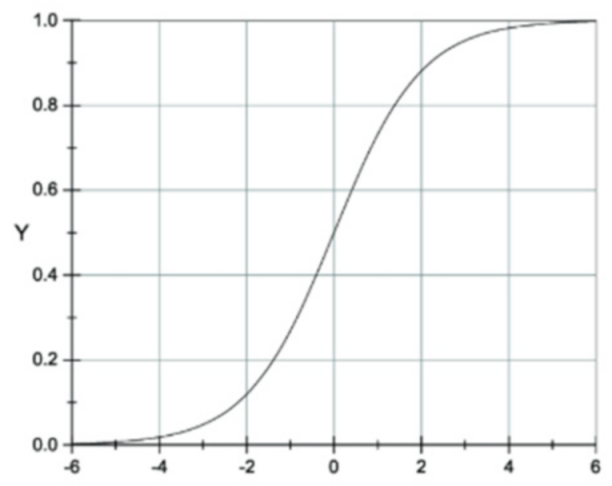
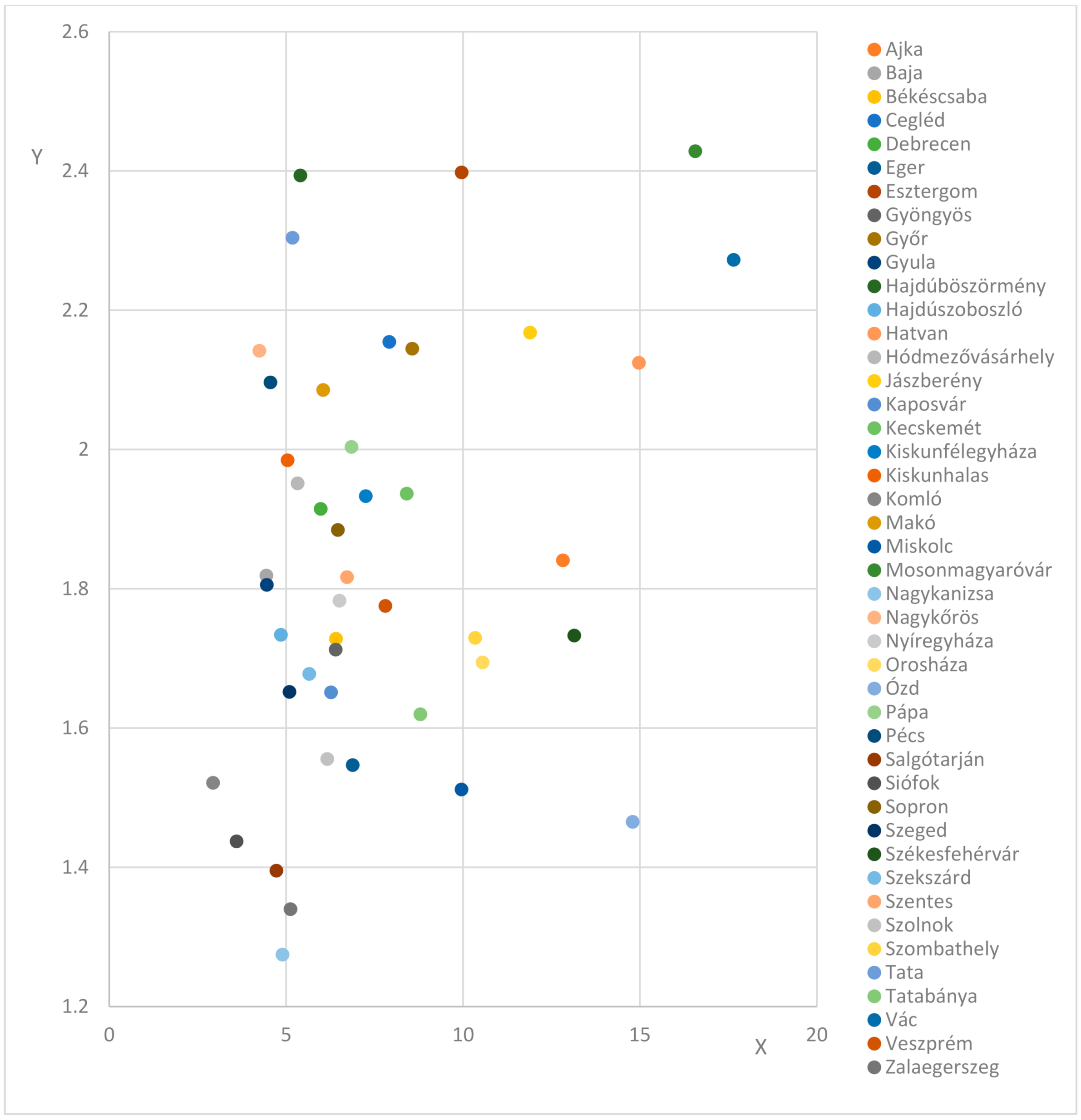

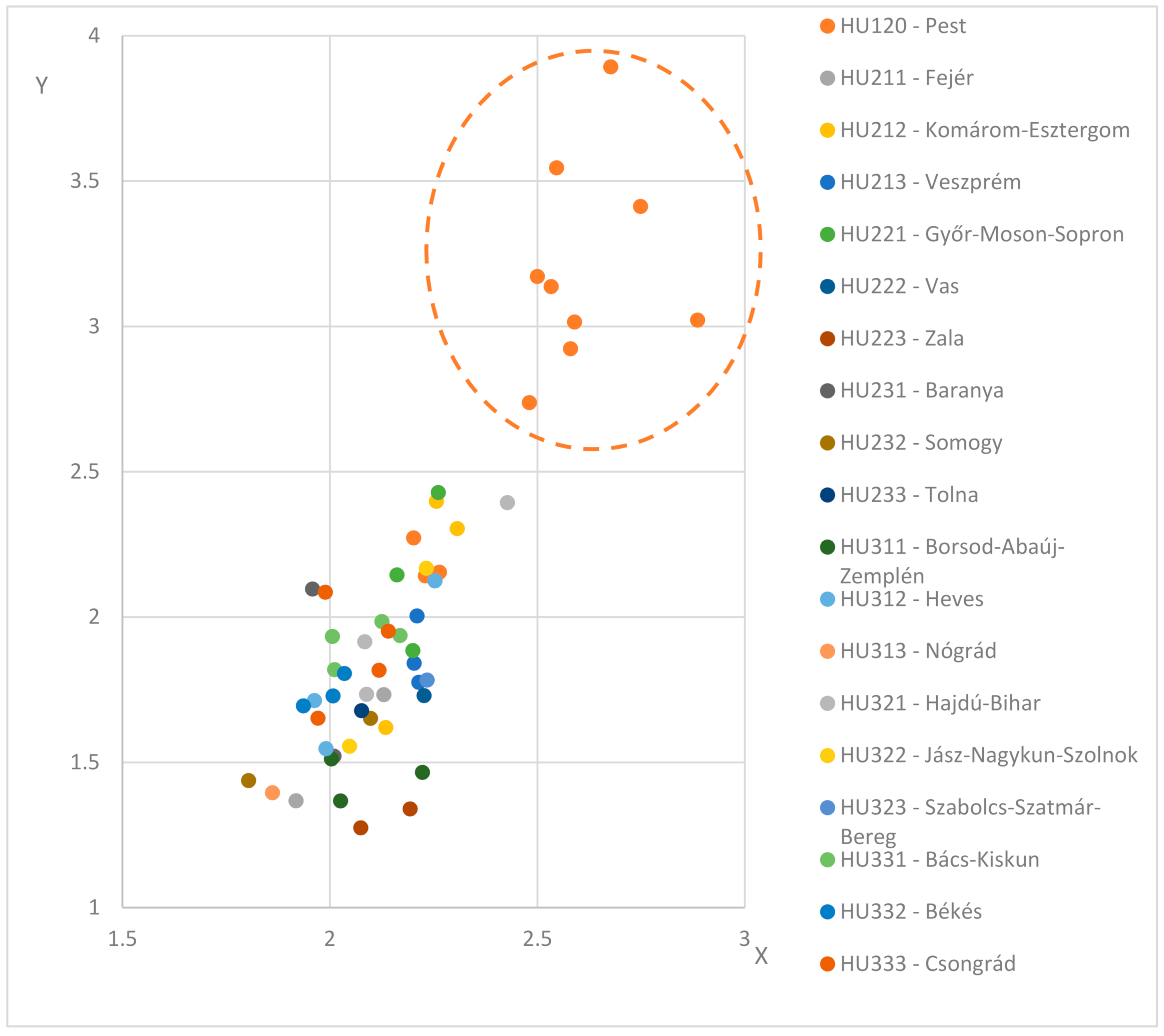

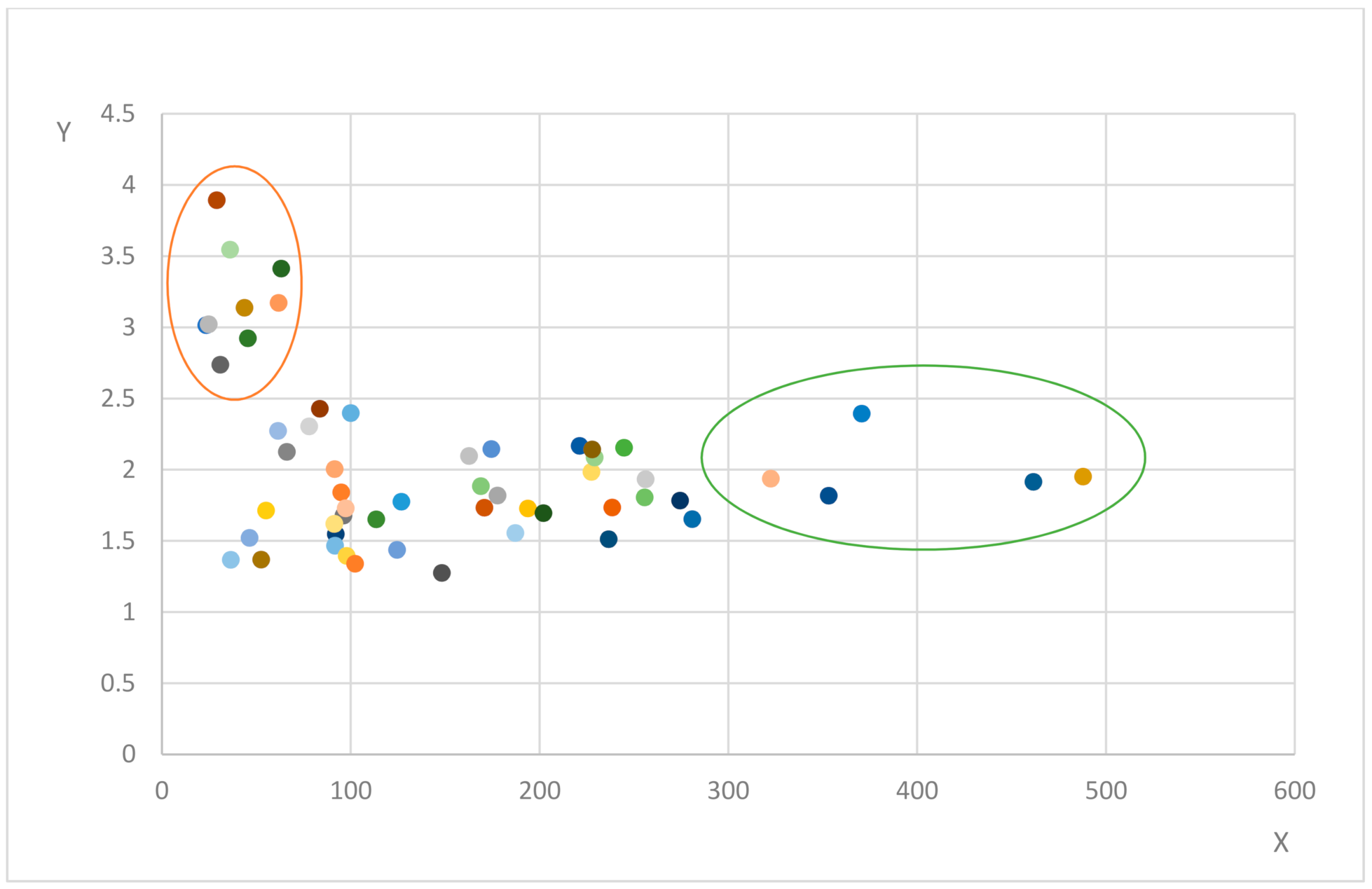
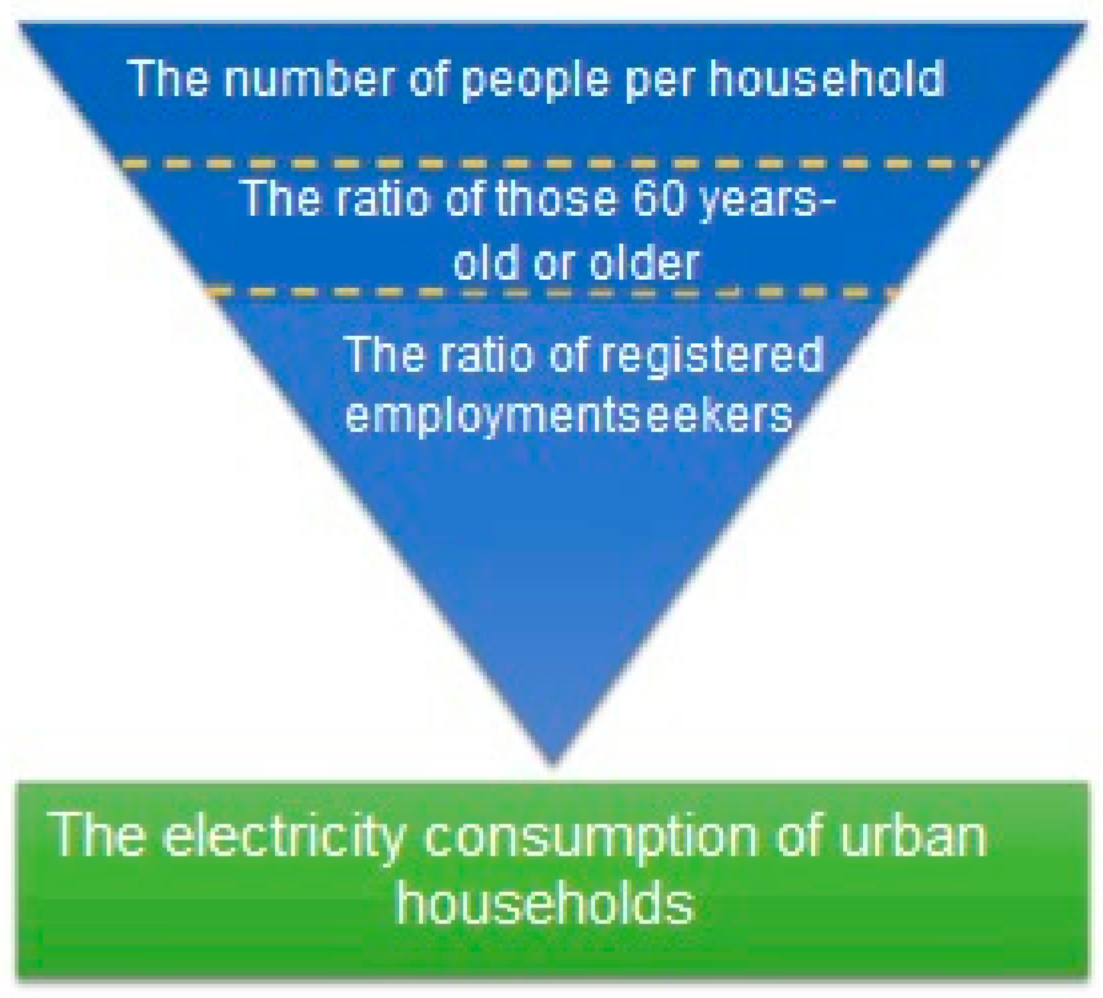
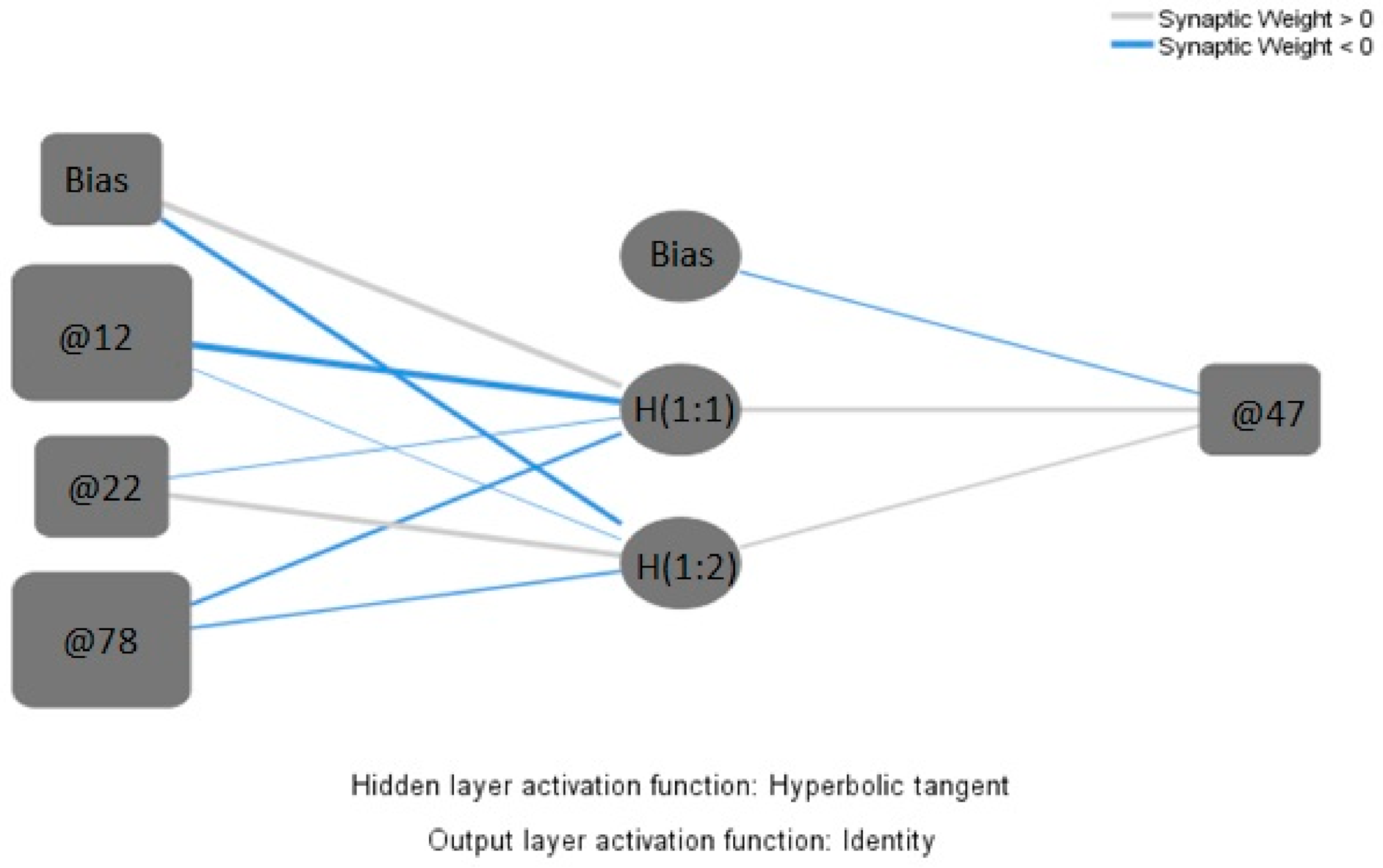

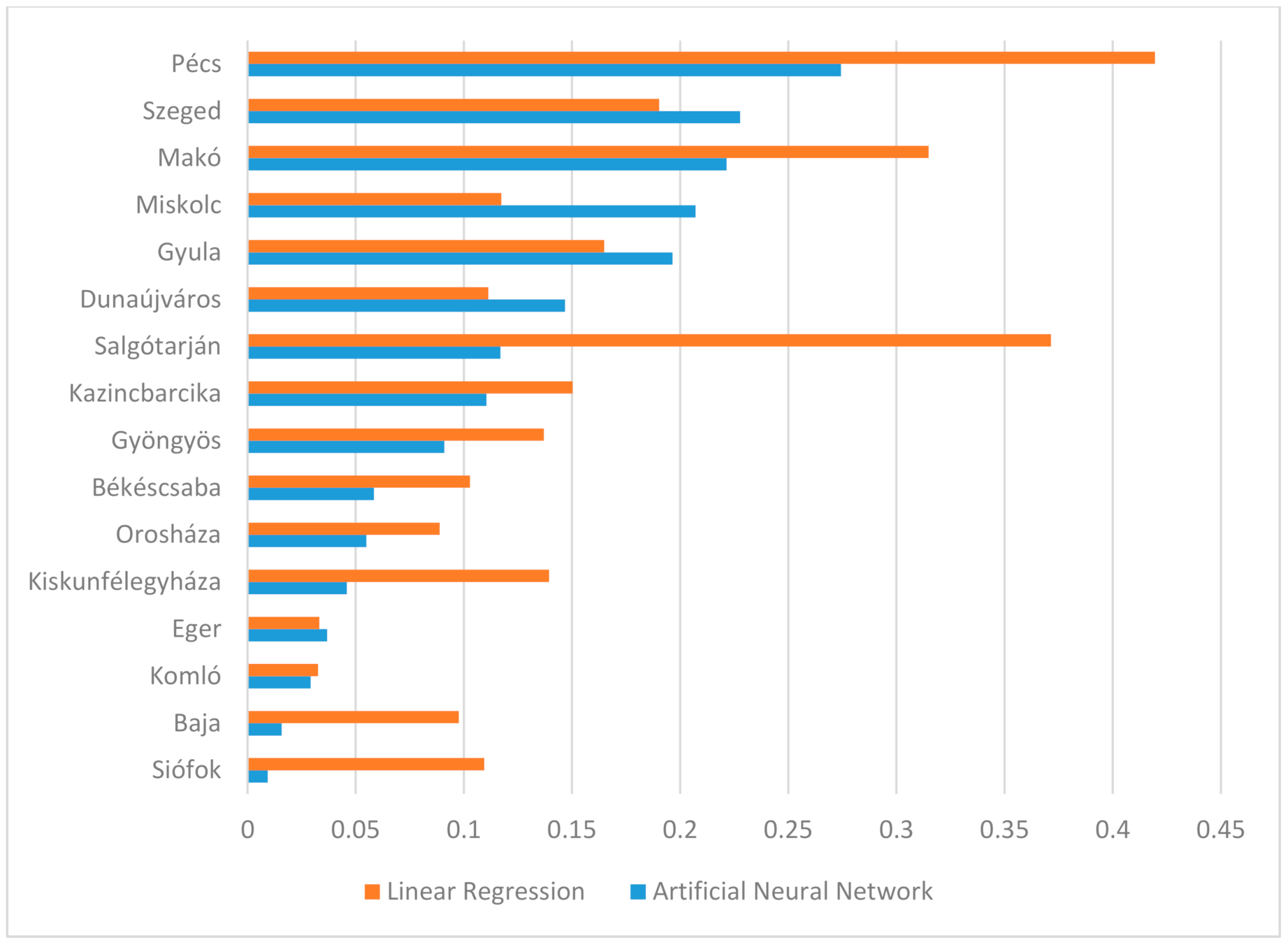
| Research Problem | Applied Methodology | Literature |
|---|---|---|
| Prediction of Ecological Pressure on Resource-Based Cities | radial basis function (RBF) Neural Network | [65] |
| Urban and economic Development and ecological footprint | Back Propagation Neural Network (BPNN) adaptive fuzzy-neural-network (RBNN-FNN) | [66,67,68,69,70] |
| Air pollution in cities | Multilayer Forward Neural Network (MFNN), FFNN | [71,72,73,74] |
| Territorial expansion | multilayer perceptron (MPL) | [75] |
| Model Summary b | |||||||||
|---|---|---|---|---|---|---|---|---|---|
| Model | R | R Square | Adjusted R Square | Std. Error of the Estimate | Change Statistics | ||||
| R Square Change | F Change | df1 | df2 | Sig. F Change | |||||
| 1 | 0.742 a | 0.551 | 0.519 | 0.21103494 | 0.551 | 17.201 | 3 | 42 | 0.000 |
| Step | ||||
|---|---|---|---|---|
| 1 | 2 | 3 | ||
| Information criterion | −121.73 | −125.215 | −100.642 | |
| Effect | @22 | ✓ | ✓ | ✓ |
| @78 | ✓ | ✓ | ||
| @12 | ✓ | |||
| ANOVA a | ||||||
|---|---|---|---|---|---|---|
| Model | Sum of Squares | df | Mean Square | F | Sig. | |
| 1 | Regression | 2.298 | 3 | 0.766 | 17.201 | 0.000 b |
| Residual | 1.871 | 42 | 0.045 | |||
| Total | 4.169 | 45 | ||||
| Model | Unstandardized Coefficients | Standardized Coefficients | t | Sig. | 95.0% Confidence Interval for B | |||
|---|---|---|---|---|---|---|---|---|
| B | Std. Error | Beta | Lower Bound | Upper Bound | ||||
| 1 | (Constant) | 2.234 | 1.244 | 1.795 | 0.080 | −0.278 | 4.745 | |
| @12 | −0.061 | 0.024 | −0.353 | −2.611 | 0.012 | −0.109 | −0.014 | |
| @22 | 0.729 | 0.328 | 0.309 | 2.223 | 0.032 | 0.067 | 1.390 | |
| @78 | −0.110 | 0.030 | −0.407 | −3.649 | 0.001 | −0.170 | −0.049 | |
Publisher’s Note: MDPI stays neutral with regard to jurisdictional claims in published maps and institutional affiliations. |
© 2021 by the authors. Licensee MDPI, Basel, Switzerland. This article is an open access article distributed under the terms and conditions of the Creative Commons Attribution (CC BY) license (https://creativecommons.org/licenses/by/4.0/).
Share and Cite
Bakó, F.; Berkes, J.; Szigeti, C. Households’ Electricity Consumption in Hungarian Urban Areas. Energies 2021, 14, 2899. https://doi.org/10.3390/en14102899
Bakó F, Berkes J, Szigeti C. Households’ Electricity Consumption in Hungarian Urban Areas. Energies. 2021; 14(10):2899. https://doi.org/10.3390/en14102899
Chicago/Turabian StyleBakó, Ferenc, Judit Berkes, and Cecília Szigeti. 2021. "Households’ Electricity Consumption in Hungarian Urban Areas" Energies 14, no. 10: 2899. https://doi.org/10.3390/en14102899
APA StyleBakó, F., Berkes, J., & Szigeti, C. (2021). Households’ Electricity Consumption in Hungarian Urban Areas. Energies, 14(10), 2899. https://doi.org/10.3390/en14102899








